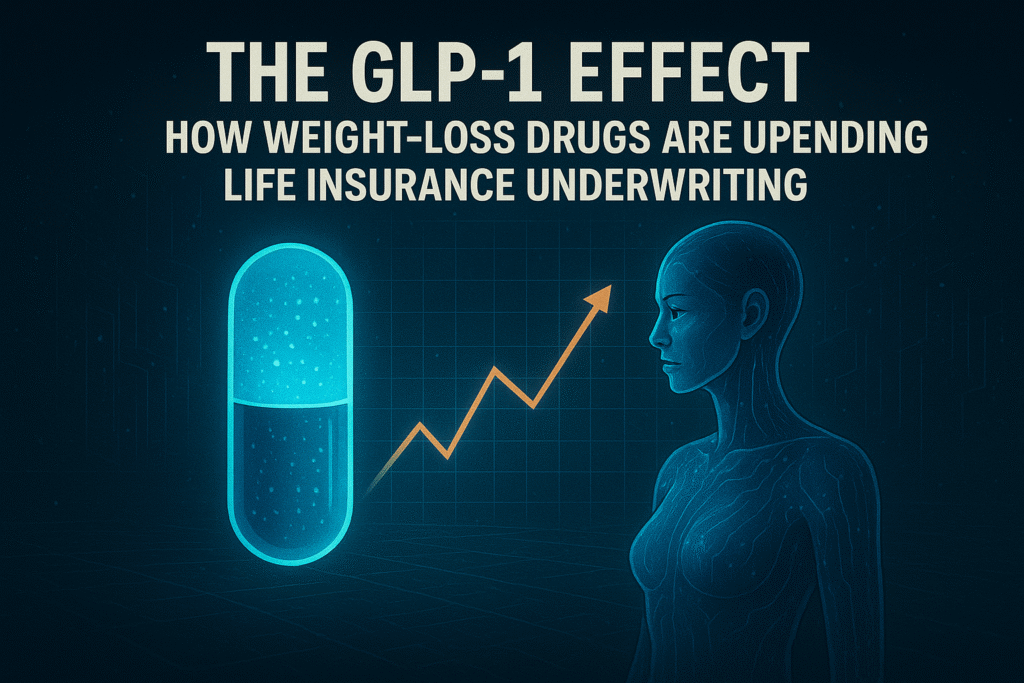The GLP-1 effect is reshaping more than waistlines. Discover how drugs like Ozempic and Mounjaro are forcing a radical rethink of life insurance underwriting, risk models, and premiums in the most significant shift in decades.
A Pharmaceutical Earthquake in a Staid Industry
For decades, the foundational principles of life insurance underwriting have remained remarkably consistent. Actuaries rely on vast troves of historical data to predict mortality risk based on immutable factors like age, gender, and family history, and modifiable ones like smoking status, blood pressure, and crucially, Body Mass Index (BMI). A high BMI has been a near-infallible predictor of higher premiums, a reflection of its strong correlation with cardiovascular disease, diabetes, and cancer.
Then came the earthquake.
A new class of drugs, Glucagon-like peptide-1 receptor agonists (GLP-1s), with brand names like Ozempic, Wegovy, Mounjaro, and Zepbound, has exploded onto the scene. They are not merely another weight-loss fad; they are proving to be profoundly effective tools for sustained, significant weight reduction and improved metabolic health. The resulting GLP-1 effect is sending shockwaves through the healthcare system, stock market, and food industry. But perhaps no sector is facing a more complex and immediate reckoning than the trillion-dollar life insurance industry.
This article delves into the unprecedented challenge and opportunity these drugs present. We will explore how the staggering efficacy of GLP-1s is forcing actuaries, underwriters, and executives to tear up old risk tables, question long-held assumptions, and fundamentally reimagine how they assess the health and longevity of millions of applicants. The GLP-1 effect is more than a trend; it is the catalyst for the most significant revolution in life insurance underwriting since the invention of the medical exam.
Understanding the Disruptor – A Primer on GLP-1 Agonists
To grasp the magnitude of the shift, one must first understand the power of the drugs causing it.
What Are GLP-1s?
Glucagon-like peptide-1 (GLP-1) is a naturally occurring hormone released in the gut after eating. It performs several critical functions:
- Stimulates Insulin Secretion: It tells the pancreas to release insulin when blood sugar is high.
- Suppresses Glucagon Secretion: It tells the liver to stop releasing stored sugar.
- Slows Gastric Emptying: It delays the rate at which food leaves the stomach, promoting a powerful feeling of fullness (satiety).
- Acts on the Brain: It targets receptors in the hypothalamus, reducing appetite and food-seeking behavior.
From Diabetes to Obesity:
Initially developed and approved for Type 2 Diabetes (e.g., Ozempic, Mounjaro), researchers noticed a powerful side effect: substantial weight loss. This led to the development and FDA approval of higher-dose versions specifically for chronic weight management (Wegovy, Zepbound).
The Efficacy That Changed Everything:
Clinical trial data is what makes these drugs a true disruptor, not just another supplement.
- Wegovy (semaglutide): The STEP trials showed an average weight loss of 14.9% of body weight over 68 weeks.
- Zepbound (tirzepatide): The SURMOUNT trials were even more striking, showing an average weight loss of 15-20.9% of body weight over 72 weeks, depending on the dose.
This level of efficacy surpasses that of any previous pharmaceutical intervention and rivals the results of bariatric surgery, but without the invasiveness.
The “Effect” Beyond Weight:
The GLP-1 effect isn’t just about kilograms lost. These drugs demonstrate profound secondary benefits:
- Cardiovascular Risk Reduction: The SELECT trial showed that Wegovy reduced the risk of major adverse cardiovascular events (MACE) like heart attack and stroke by 20% in overweight or obese adults with established cardiovascular disease.
- Improved Metabolic Markers: Significant improvements in HbA1c (blood sugar), blood pressure, cholesterol, and liver enzymes are commonly observed.
- Potential Kidney Benefits: Early research suggests possible protective effects on kidney function.
This holistic improvement in health metrics is what makes them so revolutionary for insurers. They aren’t just treating a symptom (weight); they are modifying the underlying disease of obesity and its deadly comorbidities.
The Pillars of Traditional Underwriting – Why BMI Was King
Life insurance is a business of predicting risk with mathematical precision. For years, the equation was simple when it came to weight.
The Actuarial Reliance on BMI:
Body Mass Index (BMI) has been a cornerstone of underwriting for its strong, population-level correlation with mortality. Actuarial tables are meticulously crafted, showing a clear “J-shaped” curve: the lowest mortality risk is associated with a “normal” BMI (18.5-24.9), with risk climbing steadily as BMI enters the “overweight” (25-29.9) and “obese” (30+) categories.
The Rationale for Higher Premiums:
A high BMI is a proxy for a host of expensive-to-insure conditions:
- Type 2 Diabetes: A leading cause of heart disease, stroke, and kidney failure.
- Hypertension and Heart Disease: Excess weight strains the cardiovascular system.
- Certain Cancers: Obesity is linked to higher incidence of 13 different types of cancer.
- Sleep Apnea: Which itself leads to cardiovascular complications.
- Orthopedic Issues: Accelerated wear on joints.
An applicant with a BMI of 35 could expect to pay a “table rating”—a percentage increase on the standard premium—often 50% to 200% higher. This was not punitive; it was mathematically necessary to ensure the risk pool remained solvent.
The Old Underwriting Process for Weight:
- Application: Applicant discloses height and weight.
- Medical Exam: A nurse records vitals, including height and weight, to verify.
- Calculation: Underwriter calculates BMI.
- Rating: Premium is set based on the actuarial table for that BMI, sometimes with adjustments for other health factors.
This process was static. It assessed a snapshot in time with no mechanism for predicting future improvement. The GLP-1 effect shatters this static model.
The Underwriter’s Quandary – Navigating Uncharted Risk
The arrival of GLP-1s creates a series of complex, unanswered questions for insurance companies.
1. The Adherence Problem:
These are chronic medications. What happens when someone stops taking them? Clinical data and real-world evidence show that upon cessation, the majority of lost weight is regained, and metabolic benefits reverse. How does an insurer underwrite someone today based on a drug they may not be taking in 5 years? The long-term adherence rates for these drugs are still unknown.
2. The “What Are We Insuring?” Dilemma:
Is the insurer underwriting:
- The person on the drug? (A lower-risk individual)
- The person off the drug? (A higher-risk individual)
- Or, most likely, the person’s ability to afford and tolerate the drug indefinitely? (This introduces socioeconomic and side-effect variables into risk assessment).
3. The Long-Term Data Vacuum:
While the short-to-medium-term data is spectacular, the life insurance business is played out over 30, 40, or 50 years. What are the effects of being on a GLP-1 agonist for 20+ years? Are there unforeseen long-term side effects? Actuaries operate on decades of mortality data; for GLP-1s, that data simply does not exist yet.
4. The Selection Bias Conundrum:
The first people to seek out and obtain these drugs are likely more health-conscious, affluent, and proactive—a demographic that is already a better-than-average risk. How do you separate the drug’s effect from the applicant’s inherent behaviors?
The Emerging Underwriting Playbook – How Insurers Are Adapting
Despite the challenges, insurers cannot afford to wait. They are developing new, more dynamic underwriting protocols to account for the GLP-1 effect.
1. The “Wait-and-See” (Persistence Requirement):
The most common initial approach is one of cautious optimism. Many insurers are requiring applicants to demonstrate:
- A Minimum Treatment Duration: Typically 6 to 12 months of consistent, documented use.
- Proof of Efficacy: Not just a prescription, but evidence of sustained weight loss and improved health metrics (e.g., lower HbA1c, improved blood pressure).
This ensures they are assessing a stabilized, healthier individual, not someone at the very start of their journey where rebound is a high risk.
2. The Attended Medical Exam is More Important Than Ever:
The paramedical exam becomes a critical verification tool. It’s no longer just about confirming weight; it’s about gathering concrete data to prove the drug’s effect:
- Verifying Current Weight: Confirming the BMI has indeed dropped.
- Blood and Urine Testing: Checking for improved cholesterol panels, blood sugar levels, and kidney function.
- Blood Pressure Measurement: Documenting cardiovascular improvement.
3. The New Question on the Application:
Applications are being updated. Beyond “Do you smoke?” and “What is your height/weight?”, new questions are appearing:
- “Are you currently taking any medication for weight management, including GLP-1 agonists (e.g., Wegovy, Zepbound, Saxenda)?”
- “If yes, please provide the start date, dosage, and prescribing physician.”
- “Have you experienced significant weight loss (>10% body weight) in the last 12 months? If yes, please explain.”
4. The Potential for Re-evaluation and Premium Reductions:
This is the most customer-friendly aspect of the GLP-1 effect. Some forward-thinking insurers are creating pathways for existing policyholders.
- An existing client who has successfully lost a significant amount of weight and maintained it for a year or more (with documentation) can apply for a re-evaluation of their policy.
- If their new health metrics qualify them for a better risk class, their premiums could be reduced accordingly. This transforms life insurance from a static contract into a more responsive partnership in health.
The Future Actuarial Landscape – A More Personalized Model
The GLP-1 effect is accelerating a shift that was already underway: the move from broad-stroke actuarial tables to personalized, dynamic risk assessment.
The End of BMI’s Dominance:
Underwriters will increasingly de-emphasize BMI as a standalone metric and focus more on the health outcomes that BMI was a proxy for. Blood pressure, cholesterol, HbA1c, and liver enzymes will carry more weight in the assessment.
The Rise of “Positive” Ratings:
Just as smokers pay more, could we see a future where individuals who proactively manage their health with proven medications receive a “preferred plus” rating or a discount? The GLP-1 effect opens the door to incentivizing health-positive behaviors financially.
Integration with Wearable Data:
The future of underwriting may involve a holistic digital health picture. An applicant could provide consent for their insurer to view aggregated, anonymized data from their GLP-1 prescription adherence, continuous glucose monitor, fitness tracker, and smart scale, painting a real-time picture of health that is far more accurate than a single medical exam.
The Reinsurance Recalculation:
The ripple effects go primary insurers to the reinsurance companies that insure them. Reinsurers will have to recalibrate their own complex models to account for the population-level impact of these drugs, potentially lowering the cost of reinsurance for portfolios with many insureds on GLP-1s.
Conclusion: A Healthier, More Complex Future
The GLP-1 effect on life insurance underwriting is a story of disruptive innovation meeting institutional inertia. It is forcing a centuries-old industry to evolve at an unprecedented pace. While the short-term result is underwriting complexity and caution, the long-term implications are profoundly positive.
These drugs offer a genuine opportunity to improve population health, reduce mortality, and ultimately make life insurance more affordable for millions of people. The industry’s challenge is to navigate the current data gap without stifling this potential with outdated models.
The companies that succeed will be those that develop agile, evidence-based, and fair underwriting practices that reward health improvement. They will move from being mere risk-assessors to becoming risk-mitigation partners. The GLP-1 effect isn’t just upending underwriting; it’s offering a glimpse into a future where insurance is not a penalty for poor health, but a reward for managing it.


